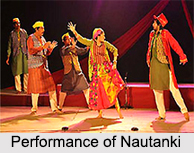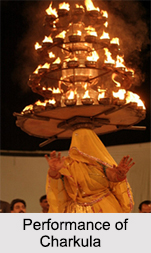 Folk dance of Uttar Pradesh shows the rich cultural heritage of the state. The dance dramas based on the mythological stories of divine characters like Lord Rama & Lord Krishna reflect the traditional essence. The major folk dance of Uttar Pradesh includes Raslila, Ramlila, Khyal, Nautanki, Naqaal, Swang, Dadra and the Charkula Dance.
Folk dance of Uttar Pradesh shows the rich cultural heritage of the state. The dance dramas based on the mythological stories of divine characters like Lord Rama & Lord Krishna reflect the traditional essence. The major folk dance of Uttar Pradesh includes Raslila, Ramlila, Khyal, Nautanki, Naqaal, Swang, Dadra and the Charkula Dance.
Raslila: The Raslila performed in this state is known as the Braj Raslila, as it was originated from the Braj area of Uttar Pradesh. It is a theatrical form, which is now performed in many Indian states. Here, the story revolves around Lord Krishna`s charming childhood, adolescence and early youth, where it explores the relationship of Lord Krishna with his consort Radha.
Ramlila: Ramlila is considered as a popular traditional folk dance of Uttar Pradesh. It primarily deals with the life of Lord Rama in Ramayana, who is also another incarnation of Lord Vishnu. This dance form depicts the story of Lord Rama"s exile from Ayodhya, his success over Ravana and his interactions with Sita.
Khyal: Khyal is another folk dance of Uttar Pradesh, which is simultaneously popular in many other Indian states and it started as a prime folk dance form in Uttar Pradesh. There are different styles in Khyal, each one is known by the name of the city, acting style, community or the author. Some popular Khyals are Jaipuri Khyal, Abhinaya Khyal, Gadhaspa Khyal, and Ali baksh Khyal, where the subtleties demarcate these variations. Generally, these folk dances are mythological, which are referring to various events in the Puranas and these are presented very creatively, though, they explore the historical aspects of these events as well. These performances are also marked by the presence of elements like romance, brave deeds, sentiment and beliefs etc.
The performances of Khyal start with an invocation, which begins with hymns to the respected deities; various instruments like the nakkara or dholak (drum), cymbals and harmonium give the music. It is said that the clown is always an integral part of this show. The cast played by males is directed on stage, by the ustad, who is mostly the producer and the director of the play. He always remains on stage & helps the artists; he even helps in prompting the script if needed.
 Nautanki: Nautanki is consisted of folklore and mythological dramas blended with folk songs and dances. Many times, the Nautanki artistes are from those families, who have been in this profession for generations. Most of them are illiterate, though a number of professional singers have also joined Nautanki mandlis. Music, which is used in this dance, is a mixture of classical and folk songs. Poems are also written in various metrical patters. The musical instrument used during the performance is Nagada. It is a single-faced kettledrum, which in fact announces a Nautanki performance in a village area.
Nautanki: Nautanki is consisted of folklore and mythological dramas blended with folk songs and dances. Many times, the Nautanki artistes are from those families, who have been in this profession for generations. Most of them are illiterate, though a number of professional singers have also joined Nautanki mandlis. Music, which is used in this dance, is a mixture of classical and folk songs. Poems are also written in various metrical patters. The musical instrument used during the performance is Nagada. It is a single-faced kettledrum, which in fact announces a Nautanki performance in a village area.
Naqaal: This folk dance of Uttar Pradesh is very popular and a preferred way of entertainment, since it is very enjoyable, and it subtly and sarcastically presents the unpleasant shadow spread on life. There is a storyteller character in all the plays of Naqaals, where generally the themes are based on a common man. The common man is generally at the center of attention at the play. Generally Mirasis, Naqaals and Bhands community people perform this art with specialized skills.
 Swang: It is a kind of folk drama that is enriched with songs. It is considered as a rich performance with literary wealth. The plot of this performance is based on the stories of great personalities; the Swangs of Puran Nath Jogi, Gopi Nath and Veer Hakikat Rai are very popular. In the Swangs of Puran Nath Jogi & Gopi Nath the lives of detachment and in Kakikat Rai`s Swang, the love of religion are presented by artistic skills. The popularity of this folk dance of Uttar Pradesh is on the conversing ability of performers.
Swang: It is a kind of folk drama that is enriched with songs. It is considered as a rich performance with literary wealth. The plot of this performance is based on the stories of great personalities; the Swangs of Puran Nath Jogi, Gopi Nath and Veer Hakikat Rai are very popular. In the Swangs of Puran Nath Jogi & Gopi Nath the lives of detachment and in Kakikat Rai`s Swang, the love of religion are presented by artistic skills. The popularity of this folk dance of Uttar Pradesh is on the conversing ability of performers.
Dadra: Dadra is an extremely popular folk dance of Uttar Pradesh. Mainly this dance form revolves around nuptial and sexual happiness. In this dance, singers give playback to the artists, who are performing on the stage; they lip-sync with the singers.
Charkula Dance: It is a traditional folk dance of Uttar Pradesh, which is widely performed in the Braj region of the state. In this performance, veiled women balance a large multi-tiered circular wooden pyramid on their heads, while dancing in various steps. The wooden pyramid is lighted with 108 oil lamps. The women dance on the `rasiya` songs of Lord Krishna.
Charkula dance is especially performed on the third day after the Holi festival. According to mythology, on this day, Radha was born. Radha`s grandmother ran out of the house with keeping the charkula on her head to announce her birth. So, Charkula dance is performed to show the pleasure and joy of a grandmother.



















